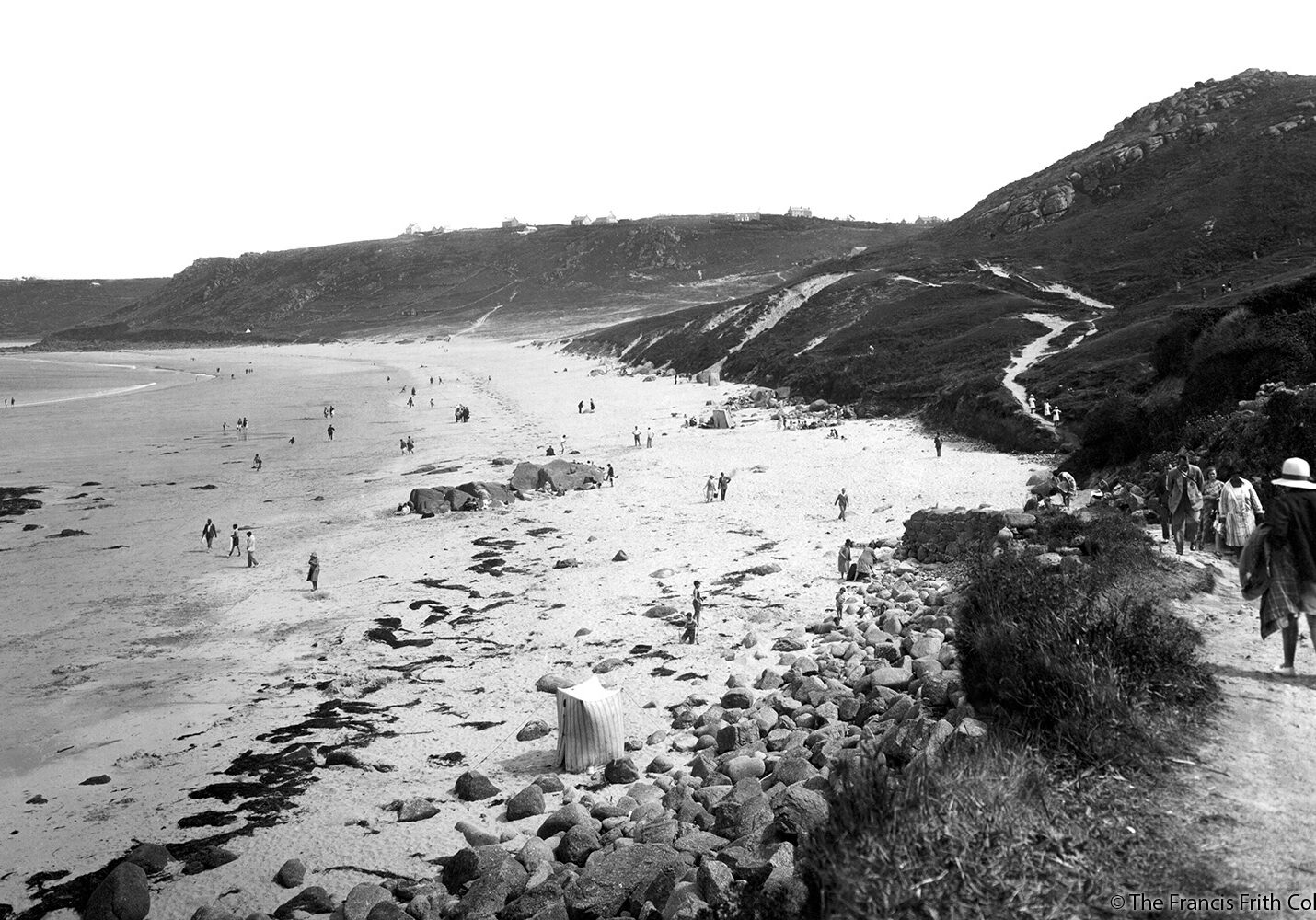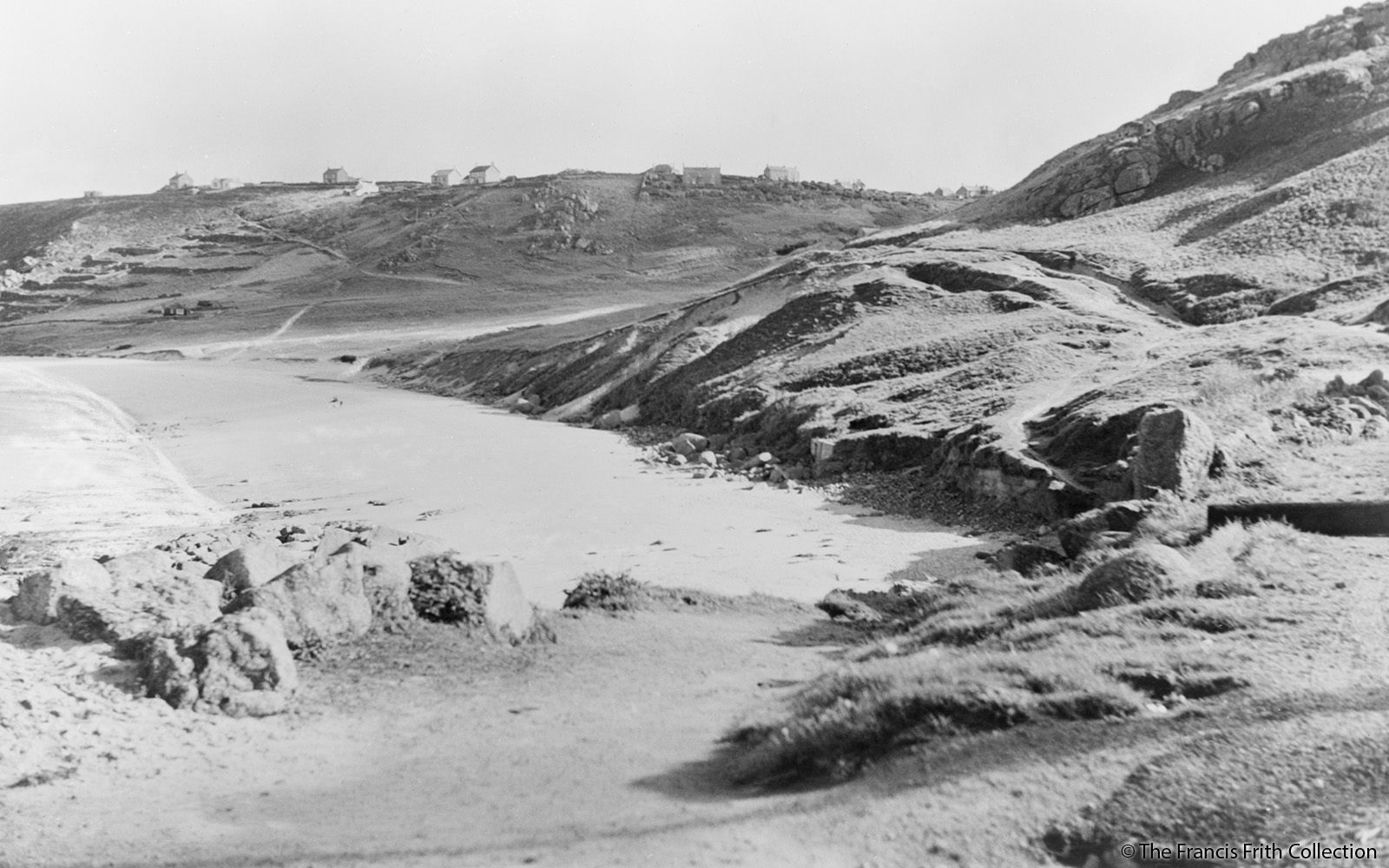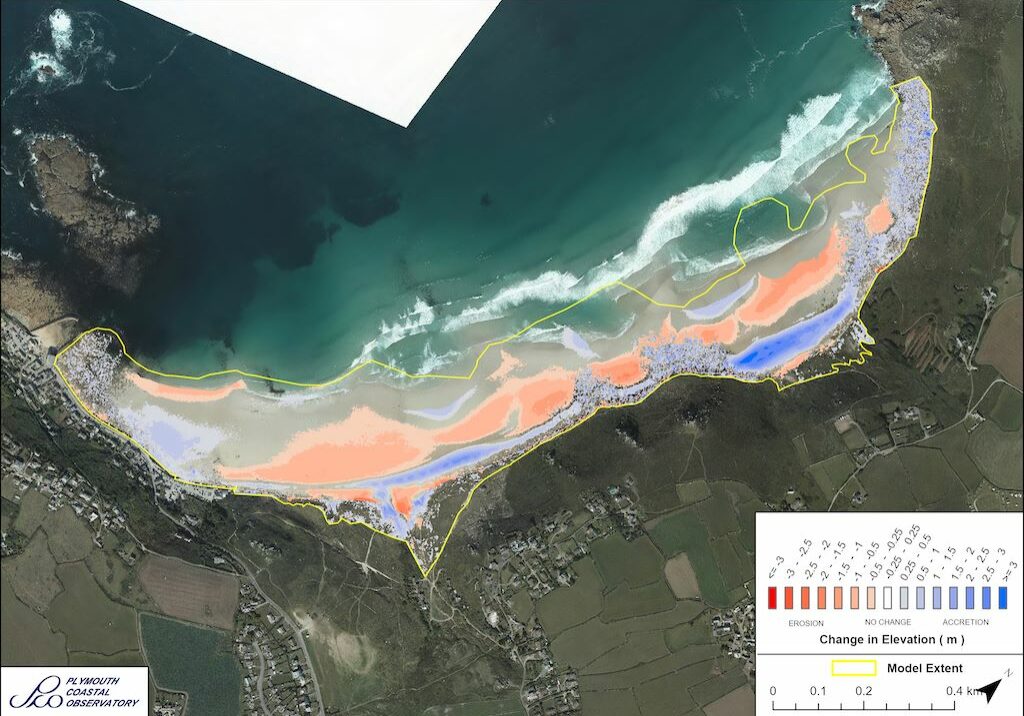
Sennen Cove is named after Saint Sennan or Sinninus and is a wide embayed north-west facing beach, north of Lands End. There are two small streams that flow onto the beach, both of which have a relatively small, steep-sided catchments.
Sennen forms part of Whitesand Bay, which stretches to the north around to neighbouring Gwynver Beach. The two beaches are separated from one another, at high water, by the Escalls Cliff in the middle of the bay. As the name of the wider bay suggests, the sand is light in colour, with a significant proportion of quartz particles and shell fragments.
Sennen Cove is a location with a contrasting coastline. To the west a breakwater and a seawall, along with the formidable Mayon Cliffs, protect Sennen village, which sits at the toe and steep slopes leading down to the beach. To the east of the seawall and village the granite cliffs and dunes majestically climb and dominate the rugged landscape.


Coastal Change
The coastline of Cornwall is an ever-changing environment. It is energetic, dynamic, never still and changes with each wave and each tidal cycle. Some of the changes we see are gradual and barely noticeable, whilst others, such as rockfalls, happen suddenly and often shockingly.
From one visit to the next it can sometimes be difficult to see how a beach and dune system has changed, but information has been collected, and is being collected through the Making Space for Sand project, to help us better understand how the coastline is changing. The purpose of this section of the website is to understand each location has changed over time, how it could change in the future and understand the policies that influence how we can respond to these changes.
Shoreline Management Plans (SMP)
The Shoreline Management Plan (SMP) is a strategic planning and management assessment tool that helps identify and measure the risk associated coastal erosion and coastal flooding. The document makes a number of policy recommendations over short, medium and long term timeframes setting out a strategic approach to managing the built, natural and historic environments associated with the coastline. Within SMP there are four policy approaches which have been assigned to stretches of coastlines. The four policies are: No Active Intervention (NAI), Hold the Line (HTL), Managed realignment (MR), and Advance the line (ATL).
Sennen Cove sits within Policy Development Zone 9 (PDZ9), in Management Area 24 (MA24), within Policy Units (PU) 24.2 and 24.3. The policy recommendations for these policy units are detailed in the table below and the SMP can be accessed through the Cornwall Council website.
Use your touchscreen
to scroll the below table
| Policy Unit | SMP2 Policy Plan | ||||
| 2025 | 2055 | 2105 | Comment | ||
| 24.1 | Undefended Cliffs
Main Policy Sub Policy
|
NAI NNtD |
NAI NNtD |
NAI NNtD |
Meets all environmental and landscape objectives. Satisfies objectives relating to the Cornwall AONB and Heritage Coast designations. Allow natural coastal evolution to occur to support conservation interest of protected sites. |
| 24.2 | Sennen Cove
Main Policy Sub Policy
|
HTL M/R |
HTL M/R |
HTL M/R |
Relatively sustainable shoreline position. Defence provides flood defence from wave run up. However, increasing sea level and storminess will increase risks to life, property and road links into the future and this will need consideration by Land Use Planners. Maintain defences to preserve historic waterside features. The coast experiences a high energy wave environment. This factor is a critical consideration in the economic case for ongoing protection.
|
| 24.3 | Whitesand Bay (Sennen & Gwynver Beaches)
Main Policy Sub Policy
|
NAI NNtD |
NAI NNtD |
NAI NNtD |
Naturally evolving beach and dunes. Relatively stable. No assets at risk. No requirement for intervention at present although need for local management of dunes could be reviewed for possible implementation of MR approach in line with some other dune systems in Cornwall in the future. |
| Key Main Policy: HTL - Hold the Line, A - Advance the Line, NAI – No Active Intervention MR – Managed Realignment
Sub Policy: NNtD – No Need to Defend, M/R – Maintain/Replace
|
|||||


National Coastal Erosion Risk Mapping (NCERM)
National Coastal Erosion Risk Mapping (NCERM) provides a baseline of coastal erosion, for the coastline of England, over short, medium and long-term timeframes. The data is based on the natural and defence characteristics of the coastline and provides rates of erosion at differing levels of confidence to help better plan for worse case scenarios. The data provided is for guidance and does not estimate the absolute location of the future coastline.
The basic NCERM lines show erosion estimates for the Short Term (ST-20 years), Medium Term (MT-50 years) and Long Term (LT- 100 years). The data is further categorised by probability: 05 is 5% probability (a 1 in 20 chance of being exceeded) Red Shading, 50 is 50% probability of being exceeded (a 1 in 2 chance of being either exceeded or not exceeded) Orange Shading and 95 is 95% probability (a 19 in 20 chance of being exceeded) Yellow Shading. Click the link below to access the Cornwall Council NCERM Mapping site read the about section then click on layers.

Historical Images
Historical photographs provide a powerful insight into how the Cornish coastline has changed within the past Century. The Making Space for Sand project are working in collaboration with the Francis Frith collection and have been given permission to share historical images on a number of beaches considered within the project.
In looking back, we can better understand how the coastline has changed, helping us understand not only how the coastal fringe has developed but also the potential future changes that we my observe. When this is considered alongside forecasts of coastal erosion and sea level rise it will help enable us to better adapt to our changing coastline.



Modelling Coastal Change

Using data that has already been collected, combined with data collected through the Making Space for Sand project, a series of models will be carried out at each location. This will help us better understand how each location may respond to sea level rise and gain a deeper understanding of how coastal sediments move and behave.
The complexity of the modelling, and the data collection that helps inform it, means that modelling outputs will not be the same on all sites. Some locations will be more thoroughly investigated to understand more complex issues and provide data that can be more widely applied to other sites with similar characteristics.
As the project develops this section of the website will expand, sharing new reports and coastal change projections when they are produced.
LiDAR surveys, which are explained on the Data Modelling page, have been carried out by the South West Coastal Monitoring program at this location. The image shared here visualises where sand has eroded (areas shaded in red) and where it has built up (areas shaded in blue), between the LiDAR surveys carried out in 2008 and 2020. The darker the shade of red or blue the greater the amount of sand erosion or accumulation has been observed. The image helps visualise that beaches are areas that change shape over time and will continue to do so as sea levels rise.


Designations
The coastline represents an important transition between the marine environment and the terrestrial environment. This transition creates a range of special habitats and exposes a range of interesting features, which that can result in these spaces being highly designated and protected. There are a range of designations that recognise a variety of different features. At this location these designations are explored below.
Special Area of Conservation (SAC)
A Special Area of Conservation (SAC) is an internationally recognised designation with the aim of protecting habitats or species that are of European importance. Land with SACs is considered to be part of a network of high-quality conservation sites, and those considered to be most in need of conservation at a European level.
Lands End and Cape Bank SAC
The Lands End and Cape Bank SAC covers and area of approximately 30,204 hectares and associated with the offshore upstanding rocky reefs and areas of sand which stretch out from the major bays and as patches between rock outcrops. The resistant headlands and islands are formed of a variety of rock types including granite, metamorphic and volcanic rocks which also form a fringing reef system. The varied geology, in combination with the exposed conditions, help make the areas extremely biodiverse.
Designated Cornwall National Landscape Area
From November 2023, all areas previously know as Areas of Outstanding Natural Beauty, or AONBs, were re-named National Landscape and in Cornwall became Cornwall National Landscape. However, the Management Plan still references the term AONB as this was formally adopted by Cornwall Council and cannot be amended until the next plan is produced.
Cornwall National Landscape areas are protected landscapes whose distinctive character and natural beauty are so outstanding that it is in the nation’s interest to safeguard them. As such they have been nationally designated by the same legislation as National Parks and have the same status and level of protection.
Image of a grey seal basking in the sun (Courtesy of Susan Scott)
West Penwith Section of the Cornwall National Landscape
The West Pentwith section covers an area of 13,762 hectares, which is 14.3% of the total Cornwall National Landscape. The key landscape characteristics of West Penwith are shaped by its granite geology and geographical position at the end of the land – exposed to the full force of the Atlantic Ocean. The hard granite coastline has been sculpted by wind and weather into a sequence of headlands punctuated by substantial cliff chasms or ‘zawns’.
Image of the sunset at Botallack (Courtesy of James Reed)
Sign up to Making Space for Sand
If you would like to get involved in helping to make dunes more resilient and biodiverse, want to help develop coastal adaptation and emergency plans or just want to know more about what the project is learning about coastal change, please click here:


